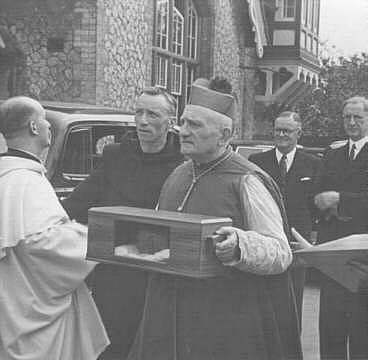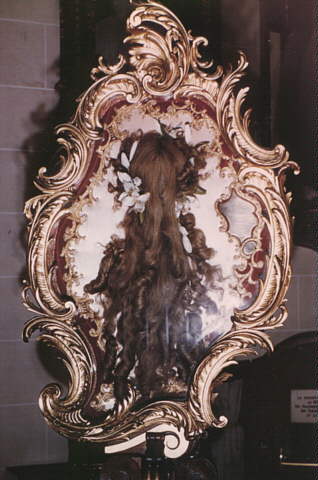Relics
| According to the Encyclopedia of Religion, a relic "can be loosely defined as the venerated remains of
venerated persons…a bone, a hair, a tooth, a garment, a footprint can carry the power or saintliness of the person
with whom they were once associated…". Relics are defined in Merriam Webster’s dictionary as "an object
esteemed and venerated because of association with a saint or martyr." However, according the Catholic Encyclopedia
"there is nothing... in Catholic teaching to justify the statement that the church encourages belief in a
magical virtue, or physical curative efficacy residing in the relic itself." Catholic History of and Doctrine Regarding Relics The veneration of relics became especially popular and widespread during the Middle Ages, during which almost all Christian churches became obsessed with the desire to obtain some relic related to almost any Christian saint or martyr. Even today, the founding stones of many of the greatest Cathedrals and churches lie at important sites of the Saints. |

|
 |
Relics range in nature from a piece of cloth worn by the Virgin Mary or some other Saint to bits of the cross
upon which Christ was crucified, to the body parts or blood of almost any saint or martyr. Christians made pilgrimages
to the sites of relics simply to touch them, and they hung bits of a saint’s or martyr’s bones around their necks.
Relics were generally believed to bring the holiness of the person into the church by including some piece of their
body or something else associated with them at that location--the saints' and martyrs' actions were modeled after
Jesus Christ, the original martyr, and therefore their bones and blood give the beholders of such sacred relics
a closer connection to Christ. The individual pieces of their bodies were believed to hold as much divine power
as the whole body and spirit of the saint had held in life. Overall, it is important to note that relics are a source of power--churches which had relics in their foundations were especially blessed, and people who owned bits and pieces of some saint had instant access to divine power. |
| A cascade of hair from Saint Therese of Lisieux, who died of Tuberculosis in 1897. From Saints Alive |
Peter Brown argues that relics were considered especially important to women who did not have the same options for education and contact with the "holy" as men did. Therefore, relics became a method for religious women, including nuns and ascetics, to become closer to and even to possess the power of various saints and martyrs; religious women's possession of relics also separated them from other women.
The invisible presences associated with the relics of the saints stood between dedicated women and the profane world: the well-educated nuns whom Matrona drew to the convent that she finally established in the suburbs of Constantinople drove the memory of the classics from their minds as they kissed and embraced the relics of the saints (273).
The divine power brought to these women by saints' relics was, in the end, considered much more desirable and important than the knowledge they had obtained in their society, and was quite likely esteemed over the theological education they were to receive in the convent.
Caroline Walker Bynum uses relics as a way to illustrate the changing notions of what would happen to the physical body at resurrection. In Resurrection of the Body, she points out that in the second century many believed that the piece of whichever saint they possessed held the complete power and grace of that saint. That, in their minds, signified that all humans' bits and pieces, however scattered they might be, would be reunited at resurrection into a complete and perfect body. In the same way that the saints' pieces contained all of their power, human body parts also contained their spirits, and God would recognize each individual by his or her pieces. By the twelfth century, the bodies of holy persons were being dismembered and scattered with fervor, in order to more widely distribute the divine power inherent in those parts. According to Bynum, this ultimately reveals a resolution on the part of Christians who had been arguing over the state of the body at resurrection.
There was a deep agreement that what happened in and to the cadaver was an expression of person...No one...suggested that the corpse was merely a husk left behind (325-6).
The human body and its parts is a locus of the power or spirit of that person; body parts are not simply body parts.
Saint Agatha's relics reside in Catania (Sicily). Agatha was a Christian martyr who probably died in the Decian persecution (249-251). According to legend, Agatha was sent to a brothel in an effort to make her repudiate her faith. Her breasts were removed and she died the next day in a prison, although legend also has it that the Apostle Peter was sent to her in a vision to cure her. Some of her remains were likely sent to Constantinople; Pope Symmachus built a church in her honor at Via Aurelia. Many people who revered her claimed that she prevented an eruption of a volcano the year after her death, and in the Middle Ages, festivals for her were thought to protect against house fires. Iconographically, she is often depicted as holding a plate with her severed breasts on it, or holding a candle.
Story of St. Agatha from the Catholic Information Network
|
|
|
St. Agatha: Miniature Stories of the Saints |
Some of her relics are considered to be in a church built by Saint Gregory; others were placed by Gregory at the monastery of St. Stephen at the Isle of Capri; still more were related to have been brought to Catania in the 12th century.
One of the reasons she is so celebrated is for maintaining her virginity in the face of a government which tried to torture her by disfiguring her body, not only by cutting off her breasts, but also by stretching, burning, and cutting her.
Followers of Saint Agatha chose to focus on the disfiguring of her body and her unwavering strength of belief in Christ which allowed her to remain virginal and pure despite having her body invaded and disfigured by her captors. This indicates that the people who spread her story emphasized her spiritual purity, so that what was being done to her physical body became unimportant. At the same time, the fact that her relics were dispersed throughout Europe indicates that her physical suffering and disfiguring were actually very important to members of the church.
Saint Thomas Becket was a chancellor of Henry II, who was eventually ordained a priest. His ideas about religion, however, clashed with those of the king, and the king began to find him a nuisance. Knights of the king murdered Thomas in Canterbury Cathedral and he was proclaimed a martyr (see the Catholic New Advent article on Thomas.) Vials of his blood were collected and sold as relics, and are sometimed considered an early form of pilgrimage souvenirs. For more information on Thomas, see the sections on Martyrs, Religious Sites, and Saints.
Andrew (circa 40 BCE - 25 CE) is remembered as the first Apostle of Jesus of Nazareth. He is the patron Saint of Fishermen and of Scotland. While performing as a missionary in Greece, he was imprisoned, tortured and hung by ropes from an X- shaped cross hence after referred to as the St. Andrew's cross. His captors executed him in the manner that they did because during his torture he seemed invulnerable to pain. For two days after his crucifixion he suffered and preached at the same time. Durring this time he was attacked by dogs and soldiers who threw stones at him. When he died, he died free from pain.
The blood of St. Andrew supposedly was used as the base for the first church in Scotland, and legend has it that Constantine was told by a monk who had a vision to take the bones to the "ends of the earth" -- at that time Brittania. The resting place of the Saint's remains is in what is today St. Andrew's in Scotland, home of the famous golf course and University.
|
|
Again the next day after John stood, and two of his disciples; And looking upon Jesus as he walked, he saith, Behold the Lamb of God! And the two disciples heard him speak, and they followed Jesus. Then Jesus turned, and saw them following, and saith unto them, What seek ye? They said unto him, Rabbi, (which is to say, being interpreted, Master,) where dwellest thou? He saith unto them, Come and see. They came and saw where he dwelt, and abode with him that day: for it was about the tenth hour. One of the two which heard John [speak], and followed him, was Andrew, Simon Peter's brother. |
|
The St. Andrew's Cross: Flag of Scotland |
--The Gospel of St. John, 1:35-40 (King James Version) |
| Even today there is evidence that some modern Christians believe that the dead bodies of certain holy or important people hold a sort of divine power. This can be seen in the way that Christians have dealt with the death of Mother Teresa. Teresa was a nun who was awarded a Nobel Peace Prize for her work with the dying, blind, disabled, aged and poor. She founded the Missionaries of Charity, whose mission was to provide comfort to the "unwanted, unloved, and uncared for"(www.cnn.com). Upon her death, her body was put on display, and tens of thousands of people showed up to view it. The viewing of her body was so important to some groups of people that they broke into the viewing area after it was closed, and eventually had to be driven by police force back out into the crowd, which was chanting "We want Mother". Evidence of modern-day relic worship is evident here--people lined up for blocks simply to view her dead body, believing that if they could be close to her, they would have access to if not divine power, then feelings of closeness to holiness and sanctity. |
|
|
Visitors to Mother Teresa's body. From www.cnn.com |
For further information consult:
Saints Alive:Authentic Relics of the Saints
The online Merriam Webster Dictionary: "Relics"
The Encyclopedia of Religion, "Relics"
The New Catholic Encyclopedia, "Agatha"
Encyclopedia of the Early Church "Agatha"
Bibliography:
Brown, Peter, The Body and Society: Men, Women, and Sexual Renunciation in Early Christianity. New York: Columbia University Press, 1988.
Bynum, Caroline Walker, Resurrection of the Body. New York: Columbia University Press, 1995.
Catechism of the Catholic Church, Mahwah, NJ: Libreria Editrice Vadicana, Paulist Press, 1989
Frankiel, Sandra S., Christianity, San Francisco: Harper Collins Press, 1985.